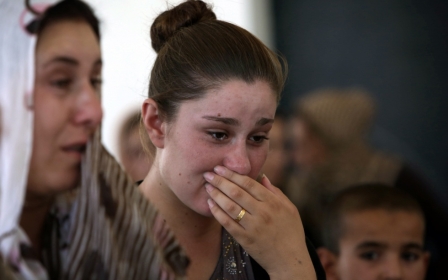IS taps into a mass culture of violence

One year after the conclusion of World War Two, US Brigadier General Samuel Marshall conducted a study into mankind’s natural resistance to killing. Having conducted hundreds of post-combat interviews, Marshall came to a remarkable conclusion: that up to 85 percent of soldiers didn’t fire their weapons at the enemy, even when their lives or the lives of their comrades depended on it.
“The great majority of individual combatants appear to have been unable or unwilling to kill,” writes Marshall in Men Against Fire.
The key takeaway from Marshall’s study into military psychology was that up to and including WW2, soldiers had been trained how to fire their weapons but had not been trained how to kill. So out went targets with circles and numbers, and in came life-like targets that emitted red paint or fell down when struck. In also came exposure to violent images. Think the movie A Clockwork Orange.
A new emphasis in training US soldiers how to kill, rather than just load and fire their weapons, resulted in a 55 percent firing rate in the Korean War, and a nearly 95 percent firing rate in Vietnam. Today, US soldiers are the most lethally trained fighting force in the history of warfare.
In summary, constant exposure to violent images and a positive feedback loop for mock kills transformed US soldiers from reluctant killers to willing and able killers.
From the 1950s to 1970s, these military training techniques were made available only to the military. Since then, Hollywood films have become more realistically violent, and video games that simulate combat are the number one form of home entertainment – with video game sales now outselling movies.
Overcoming resistance to killing
A 2015 study into the link between violence and video games concluded: “Playing video games can increase aggressive behaviour and thoughts, while lessening empathy and sensitivity toward aggression.”
What does all this mean? It means not only that the military has overcome a soldier’s resistance to killing, but also the media have performed the same task for civilians. We now all have the potential to be natural born killers.
The exponential rise in mass shootings in the US speaks to this phenomenon. Gun ownership rates really haven’t changed all that much in the past 50 years. When our resistance to killing was higher, the guns stayed at home. Until the 1990s, with the Columbine High School massacre being the marker, kids brought knives, baseball bats and hammers to school or the workplace to settle perceived injustices. Today, it’s guns.
When you lower a society’s resistance to killing as a whole, you end up producing individuals who actually desire and enjoy, well, killing.
This brings us to Islamic State (IS), also known as the Islamic State of Iraq and the Levant, or ISIL.
Combating and identifying radicalisation has befuddled everyone from Western governments to community activists, from so-called terrorism “experts” to the homeland-security-industrial complex. The Australian government warned that listening to alternative music might lead your child to “radicalisation,” while British rulers suggested eco-activism to be a telltale sign. The absurd has become the sublime.
The public demands answers. Concerned parents of highly impressionable and at risk teenagers want answers. But with IS recruiting up to 2,000 foreigners per month, the answers don’t seem to be coming.
Worship of violence
The answer may be found in religion, but not a religion of old-timey theology and philosophy, but of a more recent domain of worship: violence. Maturing counter-violent extremism studies and inside accounts of life in the self-proclaimed Islamic State suggest that it’s not ideology or even politics that fuel the terror group, but power and violence.
IS defectors routinely speak of life in the Islamic State failing to meet up to expectations set by savvy online recruiters. Abo Hamza al-Tunisi told interviewers he had bought into IS propaganda and believed he would take part in an effort to improve Iraqi society with Islam. But he quickly learned that the group had no real interest in Islamic principles and every interest in pursuing violence for violence’s sake.
“At the beginning, I thought they were fighting for Allah, but later I discovered they are far from the principles of Islam,” Hamza told The Independent. He said IS fighters were more preoccupied with raping, executions and killing “indiscriminately”.
Other defectors have explained how beheadings have become both a “rite-of-passage” and even a form of entertainment itself. On occasions where IS have run out of Shiite hostages to execute, a Sunni Muslim, often plucked randomly, is made to stand in, which further highlights how the urge for violence supersedes ideology.
Grand theft auto - not the Quran
Western journalists who have been released by or escaped from IS have told how they saw no evidence of practised Islam, not even so much as a visible copy of the Quran. A British Muslim woman who spent 10 months with the Islamic State said there was a “gangster kind of mentality even among the single women there,” adding they’d sit around all day talking about violence, war and killing while “huddled around their laptops watching ISIS videos together”.
Most of IS’s online propaganda is disproportionately targeted towards Westerners – with the subliminal messaging reading: “Come to Iraq and Syria and play out the same violent acts you fantasise over while playing Call of Duty, or Grand Theft Auto, and terrorise those who have bullied and discriminated against you in high school.”
It really is no more sophisticated than that, and the messaging works for two reasons: young Muslim males are marginalised in their white, Western, Christian-Judeo male dominated communities, and secondly, as mentioned earlier, our resistance to killing has been lowered – filtering in those who desire bloodshed and violence.
Contrasting the respective messaging of both al-Qaeda and IS is telling. Whereas al-Qaeda propaganda called on Muslims to right the imperialistic wrongs of the US in Saudi Arabia, Israel in Palestine, and Russia in Chechnya, IS makes definable appeals to violent urges and impulses. Whereas the theme of al-Qaeda’s messaging read, “Join your Muslim brothers to fight the Western colonial oppressors,” that of IS reads: “Shoot, kill, torture and behead.”
“With its heady media mix of graphic violence and utopian idylls, IS has sought recruits and supporters who are further down the path toward ideological radicalisation or more inclined by personal disposition toward violence,” observes Jessica Stern and JM Berger in ISIS: The State of Terror.
When it comes to radicalisation, there are many pathways to the bottom of the mountain, so to speak. While too much attention has been given to Islamic scripture, and not enough to what former jihadist Mubin Shaihk described to me as the “four-step” radicalisation process – whereby terrorists of all stripes internalise the following mantra: “It isn’t right. It isn’t fair. It’s your fault. I must do something” – it appears the base motivation for violence has been wholly ignored.
Ignored – that is except by ISIS. The modern-day appetite for violence has helped turn ISIS into the world’s most successful terrorist organisation. It would pay us well to understand what it is they already know.
- CJ Werleman is the author of Crucifying America (2013), God Hates You. Hate Him Back (2009), and Koran Curious (2011), and he is the host of Foreign Object. Follow him on twitter: @cjwerleman
The views expressed in this article belong to the author and do not necessarily reflect the editorial policy of Middle East Eye.
Photo: Students, staff and faculty are evacuated from Umpqua Community College in Roseburg, Oregon, after a deadly shooting at the school on 1 October, 2015. (AFP)
New MEE newsletter: Jerusalem Dispatch
Sign up to get the latest insights and analysis on Israel-Palestine, alongside Turkey Unpacked and other MEE newsletters
Middle East Eye delivers independent and unrivalled coverage and analysis of the Middle East, North Africa and beyond. To learn more about republishing this content and the associated fees, please fill out this form. More about MEE can be found here.





